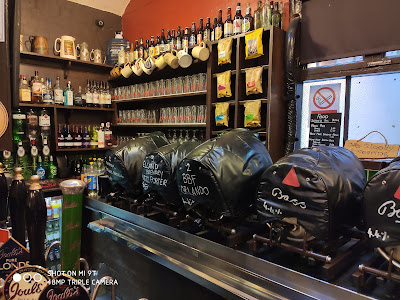The arrival of spring heralds the start of the gardening season, and whilst I’m not a fanatical gardener, by any stretch of the imagination, there’s plenty of tidying up to be done, along with preparation for the summer months.
So, with the weather dry and fair, albeit a little on the cold side, the chance to get out into the fresh air was not one to be missed, especially after a hectic week, couped up in the office. Also, with lock-down restrictions still in place and exercise limited to within a certain radius of one’s home (who monitors this sort of thing?), it wasn’t as if I could go to the pub or continue my walk along the North Downs Way.
Instead, I spent the majority of the weekend digging, raking, sawing and pulling. I ached all over, in muscles I never knew I had, but I accomplished quite a lot and have to say I am pleased with what I’ve achieved so far. The weekends that started from the beginning of the year, have seen two trees getting a severe cut-back and pruning. These are a coppiced hazel in the front garden – the one which the squirrels strip the nuts off, before we’ve even realised they are ripe.
The other tree is a horse chestnut in the back garden, that grew from a conker which came from a tree in my parents’ garden. That tree was also grown from a conker which yours truly found sprouting. Despite the sentimental attachment to this tree, it’s growing in the wrong place and if left to grow freely would end up shading out a large section of the garden, so every few years it receives a severe haircut.
I’ve also got the truncated remains of six leylandii conifers that stand in a row in front of our new fence, to remove. Seeing them there, minus most of their foliage and topped by the remnant of a crown, reminds me of those photos of the Battle of the Somme, so much so that they’ve got to go.
I managed to get rid of one over the weekend, but it involved digging away at the roots and then cutting through them with a pruning saw. That task completed as best as possible, it was then a case of rocking the tree back and forth before pushing against it with my entire body weight. Fortunately, the remaining piece – a difficult to reach tap root, gave way before I did, but I’m not looking forward to repeating this process with the remaining five!
So, what happens with all the twigs, branches and thicker sections of wood, I hear you ask? The twigs and smaller branches are cut into shorter lengths using secateurs and/or loppers and placed in the garden waste bin. This is a container that households wishing to make use of this service have to pay for, but the fortnightly collections are worth every penny in my book.
The larger branches are cut into suitable lengths, with the really thick sections of tree trunk split with an axe, before being sacked in my log store, be seasoned and eventually burned in our log-burner. We’ve only lit the burner a couple of times this winter, as apart from a cold spell, earlier in February, the winter has been relatively mild.
Some individuals claim that log burners aren’t environmentally friendly – probably the same people who heat their home with gas. Both are fossil fuels, but the logs we burn are sustainable – being home grown, and if that excess wood was removed for chipping say, it would still release CO2 as the chippings slowly rotted.
Apart from the tree and brushwood removal, my main project was finishing the preparation of the seed bed for our wildflower garden. This is a large rectangular plot, close to the house. I’d dug it over and removed the bulk of the weeds, over the Christmas recess, and then spent the past two weekends given it a subsequent weed, before raking it over a couple of times.
So, with the soil levelled and raked to a fine tilth – as all good gardeners would say, I set about sowing the seeds. I sprinkled several varieties of mixed wildflowers and other native species into some kiln-dried sand in the bottom of a bucket, gave the whole lot a good stir and then scattered the mix onto my carefully prepared piece of ground and lightly raked it all in. Now all I’ve got to do is sit back and wait, whilst nature takes its course.
That was my lock-down weekend for early March – not particularly exciting, but needs must and all that. At least I’ve used what is effectively dead time, wisely, but how I long to start seeing people, go places and do something rather more exciting!
The final photo shows 2019's effort on the wild flower front.

































